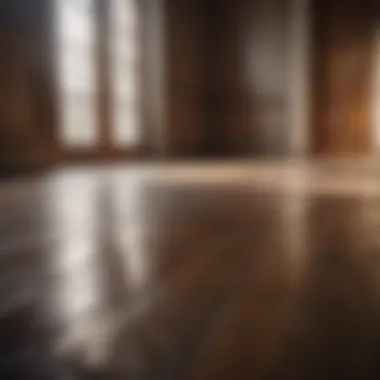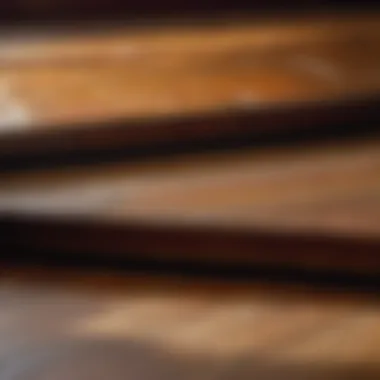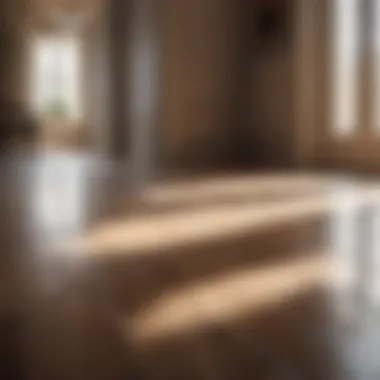Materials:
- Floorboard restoration kit
- Sandpaper (various grits: 80, 120, 220)
- Wood filler
- Wood stain
- Polyurethane sealant
DIY Steps:
- Begin by inspecting the floorboards for any damage or decay.
- Sand the floorboards with the 80-grit sandpaper to remove old finish and imperfections.
- Fill any cracks or holes with wood filler, ensuring a smooth surface.
- Sand the floorboards again, using the 120-grit and then 220-grit sandpaper for a finer finish.
- Apply wood stain with a brush or cloth, following the grain pattern for even coloring.
- Let the stain dry completely before adding a protective layer of polyurethane sealant.
Technical Aspects:
- Tools: Orbital sander, paintbrush, clean cloth
- Timing: Allow for drying time between sanding, staining, and sealing
- Techniques: Feathering edges when applying wood filler, overlapping strokes with polyurethane
DIY Project Process:


- Start by preparing the workspace, ensuring proper ventilation and adequate lighting.
- Sand the floorboards in sections, working systematically from one end to the other.
- Maintain a steady hand when applying wood stain to achieve consistent coloring.
- Wait for each coat of sealant to dry before applying additional layers for optimal protection.
Troubleshooting Tips:


- If wood filler shrinks after drying, reapply in thin layers to fill gaps completely.
- For uneven stain application, sand lightly between coats to blend colors seamlessly.
Introduction


Understanding Floorboard Restoration
The process of floorboard restoration encompasses a range of benefits that make it a popular choice among homeowners seeking to breathe new life into their living spaces. One significant advantage of floorboard restoration is its ability to preserve the charm and character of original hardwood floors, adding a touch of elegance to any room. Additionally, restoring floorboards is a sustainable practice that aligns with eco-friendly trends, appealing to environmentally-conscious individuals.
When it comes to the common types of floorboards, the selection plays a crucial role in determining the restoration approach. Different materials, such as hardwood and softwood, offer unique characteristics in terms of durability, appearance, and maintenance requirements. Understanding these distinctions is vital for making informed decisions when planning a floorboard restoration project.
Importance of Cost Analysis
The importance of analyzing restoration costs cannot be overstated, as it serves as the foundation for effective budgeting and project planning. Factors influencing restoration costs include the type of floorboard material, the extent of damage present, and the chosen restoration method. By conducting a detailed cost analysis, homeowners can gain clarity on the financial commitment required and make informed choices that align with their budgetary constraints.
When delving into budgeting for floorboard restoration, meticulous planning is essential to avoid unexpected expenses and ensure a successful outcome. Establishing a realistic budget that accounts for materials, labor, and unforeseen contingencies is key to managing costs efficiently. By prioritizing budgeting considerations, homeowners can navigate the restoration process with confidence and achieve the desired results within their financial means.
Factors Affecting Restoration Costs
Restoration projects involve various factors that directly influence the costs incurred. In the realm of floorboard restoration, understanding these factors is crucial for effective planning and budget allocation. By comprehensively evaluating the specific elements affecting restoration expenses, individuals can make informed decisions that align with their financial capabilities and desired outcomes. The benefits of delving into factors affecting restoration costs include the ability to prioritize resource allocation, tailor restoration techniques to specific needs, and avoid unexpected financial setbacks. Moreover, considering these elements allows for a realistic assessment of the overall restoration process, ensuring a smooth and cost-effective experience for individuals embarking on floorboard restoration projects.
Floorboard Material
Hardwood vs. Softwood
When considering floorboard material for restoration, the choice between hardwood and softwood plays a significant role in determining restoration costs. Hardwood, prized for its durability and aesthetic appeal, often commands a higher restoration price due to its premium quality and longevity. Softwood, while more budget-friendly, may require more frequent restoration cycles, resulting in long-term costs that rival those of hardwood. Homeowners seeking a balance between cost-efficiency and quality may opt for hardwood for its superior resilience, while those on a stricter budget might find softwood a more suitable choice. Each material's unique features contribute to the overall restoration process, necessitating careful consideration based on individual preferences and financial constraints.
Specialty Woods
In some cases, homeowners may opt for specialty woods for their floorboard restoration, adding a touch of uniqueness and luxury to their living spaces. Specialty woods bring a sense of exclusivity and sophistication to a property, reflecting the owner's distinctive style and preferences. However, utilizing specialty woods in restoration projects can significantly impact overall costs, as these materials often come at a premium price compared to standard hardwood or softwood options. Understanding the advantages and disadvantages of specialty woods is paramount when assessing restoration budgets, ensuring that the additional costs align with the desired aesthetic and long-term investment goals. Homeowners with a penchant for distinctive design elements may find the allure of specialty woods worth the higher restoration expenses, ultimately enhancing the overall appeal and value of their restored floorboards.
Cost-Effective Restoration Solutions
Cost-effective restoration solutions play a crucial role in the overall process of floorboard restoration. In this article, we delve deep into exploring practical and budget-friendly ways to revitalize your floorboards without breaking the bank. Understanding the significance of cost-effective restoration solutions can help homeowners make informed decisions and ensure their floorboards are restored to their former glory efficiently and economically.
Refinishing Techniques
Sanding and Staining:
Sanding and staining are foundational techniques in floorboard restoration, contributing significantly to the overall aesthetic and durability of the flooring. Sanding helps to smoothen out imperfections and prepare the surface for staining, giving the floorboards a renewed appearance. The key characteristic of sanding and staining lies in their ability to enhance the natural beauty of the wood while providing a protective layer against wear and tear. This technique is popular for its ability to bring out the rich tones and grain patterns of various wood species. While sanding and staining can significantly improve the look of floorboards, it requires careful execution to achieve optimal results.
Eco-Friendly Options:
Embracing eco-friendly options in floorboard restoration aligns with sustainability goals while benefitting both the environment and indoor air quality. Choosing eco-friendly finishes and stains reduces the exposure to harmful chemicals, making it a wise choice for health-conscious homeowners. The key characteristic of eco-friendly options lies in their low VOC content and biodegradable nature, ensuring a safer and greener approach to floorboard restoration. These options offer advantages such as minimal environmental impact, improved air quality within the home, and a healthier living space. While eco-friendly options may require additional research and investment, their long-term benefits make them a compelling choice for environmentally aware individuals.
Repair Alternatives
Patchwork:
Patchwork serves as a versatile repair alternative in floorboard restoration, allowing homeowners to address localized damages without replacing the entire flooring. The key characteristic of patchwork lies in its targeted approach to repair specific areas, saving time and costs associated with extensive restoration projects. This technique is beneficial for addressing minor damages such as scratches, gouges, or small cracks, restoring the floorboards' appearance and functionality. While patchwork offers a practical solution for minor issues, it may require skill and precision to seamlessly blend the repaired sections with the existing flooring.
Overlay Options:
Overlay options provide a creative solution for enhancing the aesthetics of floorboards without extensive refinishing or replacement. By adding overlays such as decorative patterns or inlays, homeowners can customize their flooring to suit their style preferences. The key characteristic of overlay options lies in their ability to transform the look of floorboards quickly and affordably, offering a fresh new appearance without the need for extensive sanding or staining. This choice is popular for its versatility and ability to update the flooring's design without disrupting the entire space. While overlay options can instantly elevate the look of floorboards, careful consideration of design cohesion and durability is essential for a successful outcome.
Conclusion
In the realm of floorboard restoration costs, the conclusion serves as a vital component, encapsulating the key takeaways and insights gathered throughout this comprehensive guide. As homeowners embark on the journey of restoring their floorboards, concluding with a solid understanding of the financial aspects is imperative. This article has meticulously examined various factors influencing restoration expenses, shedding light on budgeting strategies and cost-effective solutions to revive floorboards to their former grandeur.
Summarizing Restoration Costs
Final Budgeting Tips
Final Budgeting Tips play a pivotal role in the overall restoration process, offering crucial guidance on how to manage and monitor expenditures effectively. A standout characteristic of Final Budgeting Tips is their ability to provide clarity and structure to the financial aspect of restoring floorboards. They act as a compass, navigating homeowners through the intricacies of budgeting, ensuring a well-managed restoration project.
Embracing Final Budgeting Tips proves to be a popular choice in this article as it empowers individuals to set realistic financial targets, avoid overspending, and prioritize essential restoration tasks. This approach not only streamlines the budgeting process but also instills discipline and foresight, contributing to a successful floorboard restoration endeavor.
The unique feature of Final Budgeting Tips lies in their adaptability to diverse restoration scenarios. Whether addressing minor repairs or opting for a full restoration, integrating these budgeting tips ensures a balanced and financially prudent approach. While they offer a wealth of advantages such as minimizing costs, guiding investment decisions, and fostering a financially sustainable restoration plan, it's essential to remain vigilant of potential limitations or unforeseen expenses that might arise during the restoration process.
Long-Term Investment Considerations
Long-Term Investment Considerations underscore the enduring value that floorboard restoration can bring in the long run. By contemplating the sustainability and longevity of the restoration project, homeowners can make informed decisions that transcend immediate cost implications. A key characteristic of Long-Term Investment Considerations is their emphasis on the holistic impact of restoration efforts, considering both short-term expenses and long-term benefits.
These considerations emerge as a beneficial choice in this article by affording individuals the opportunity to assess the return on their investment in floorboard restoration. They highlight the significance of quality materials, professional craftsmanship, and strategic planning to maximize the long-term value and aesthetic appeal of restored floorboards. Additionally, Long-Term Investment Considerations prompt homeowners to evaluate the environmental sustainability and durability of their restoration choices.
The unique feature of Long-Term Investment Considerations lies in their capacity to foster a conscious and forward-thinking approach to floorboard restoration. While they offer advantages such as increasing property value, enhancing indoor aesthetics, and reducing maintenance costs in the long run, it's crucial to acknowledge any potential disadvantages such as initial high costs or extended project timelines. By balancing these factors, homeowners can make informed decisions that align with their long-term vision for their living space.





